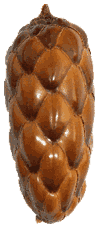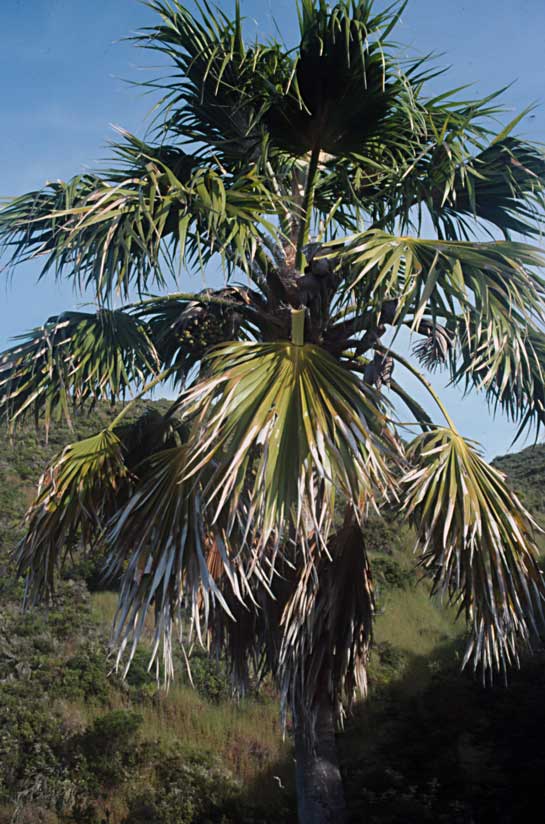 |
Palm |
 |
Palm |
Molokai, Hawaii, USA
Pritchardia munroi is a small palm 4 or 5 m in height, with a smooth, gray-brown stem 20 cm in diameter. The open crown may have 15–25 leaves. The upper surfaces of these small leaves are pale green and smooth; underside of leaf surfaces are glabrous, pale green. The underside of the leaf blade surface has scattered, small lepidia; the leaf segments are deeply divided into long acuminate drooping tips. The petioles have sparse silvery tomentum, which becomes smooth on the upper surface; the lower surface has pale brown scales. The inflorescences are shorter than the petioles, and they branch into 1 to 2 panicles; rachillae bear a dense, villous, grayish brown tomentum. The small sub-globose fruits ripen to black and are ca. 22 mm x 23 mm.
Pritchardia munroi was discovered in 1920 by Joseph F. Rock on the island of Molokai and named it after James Munro, manager of Molokai Ranch. It is known from only two individuals in a mesic gulch above Kamalo, Molokai at 610 m elevation. It is among the most endangered palm known in the wild. Like all of the Hawaiian Pritchardia, seed viability is high (90–100%), but in situ reproduction is not successful. Introduced honey bees (Apis mellifera) have been observed visiting cultivated P. munroi flowers, and wind may also contribute to the success of pollination.
 |
| One of two remaining specimens of Pritchardia munroi. Photo by S. Perlman. |
Predation of P. munroi seeds occurs from introduced rats (Rattus rattus, R. exulans, and R. norvegicus). Habitat destruction from introduced vertebrates such as deer (Odocoileus hemionus columbianus), goats (Capra hircus), and pigs (Sus scrofa) limits recruitment of P. munroi seedlings. Fire and stochastic events present threats. Invasive weeds such as grasses (Paspalum conjugatum) and guava (Psidium guajava, P. cattleianum) can form weed mats and out-compete young palm seedlings. Pests and disease are a constant threat. Existing threats include the two-spotted leaf hopper (Sophonia rufofascia), and Phytophthora, as well as serious potential threats if introduced, such as the West Indian sugarcane borer (Metamasius hemipterus) or Lethal Yellowing disease and its known vector the palm cixiid (Myndus crudus).
One individual of P. munroi has the protection of an exclosure provided by the Nature Conservancy of Hawaii (TNCH) to prevent grazing animals and pigs from access. The individual within the exclosure has had its seeds collected and propagated within private collections as well as over 30 botanic gardens internationally. Strategies for successful tissue culturing and preservation of samples have been developed by the University of Hawaii, Lyon Arboretum, USA. The United States Fish and Wildlife Service (USFWS) have produced in detailed researched recovery plans for P. munroi, and the species is recognized by the Center for Plant Conservation (CPC), which provides educational awareness.
Recommended management strategies include: protection of in situ populations, an additional exclosure around the second individual, add rat baiting, invasive weed management, and long-term monitoring; establishment of new wild populations; establishment of effective ex situ populations; collaboration to accomplish conservation biology research; adherence to invasive weed, pest management, and quarantine procedures. There is a need to establish reliable protocols for seed storage, including effective seed banking as a conservation tool.
Melany H. Chapin, Ph.D., Bishop Museum Research Associate, Hawaii, USA.
Mike Maunder, Ph.D., Center for Tropical Plant Conservation, Fairchild Tropical Garden, Coral Gables, Florida, USA.
Beccari, O. & J.F. Rock. 1921.
A monographic study of the genus Pritchardia.
Memoirs Bernice P. Bishop Museum 8: 1–77.
Chapin, M.H. 2004.
The Palms of Hawaii.
Palms & Cycads: Palm & Cycad Societies of Australia (PACSOA) 83/84: 4–10.
Chapin, M.H. 2004.
Rat damage on native Hawaiian palms.
Palms 48: 153–155.
Chapin, M.H., K.R. Wood, S.P. Perlman & M. Maunder. 2004.
A review of the conservation status of the endemic Pritchardia palms of Hawaii.
Oryx 38: 273–281.
Cuddihy, L.W. & C.P. Stone. 1990.
Alteration of native Hawaiian vegetation.
University of Hawaii Press. Honolulu, Hawaii.
Johnson, D. (ed.). (1996)
Palms, their conservation and sustained utilization.
IUCN/SSC Palm Specialist Group, Cambridge, UK.
Maunder, M., B. Lyte, J. Dransfield & W. Baker. 2001.
The conservation value of botanic garden palm collections.
Biological Conservation 98: 259–271.
Pritchard, H.W., M.I. Daws, B.J. Fletcher, C.S. Gamene, H.P. Msanga & W. Omondi. 2004.
Ecological correlates of seed desiccation tolerance in tropical African dryland trees.
American Journal of Botany 91: 863–870.
Sakai, A.K., W.L Wagner & L.A. Mehrhoff. 2002.
Patterns of endangerment in the Hawaiian flora.
Systematic Biology 51: 276–302.
USFWS. 1996.
Recovery Plan for the Molokai Plant Cluster.
Portland, OR: U.S. Fish and Wildlife Service. p.143.
USFWS. 2001.
U.S. Fish and Wildlife Service Species List. March 30, 2000.
Honolulu: Unpublished. U.S. Fish and Wildlife Service. p.19.
Wagner, W.L., D.R. Herbst & S.H. Sohmer. 1990.
Manual of the flowering plants of Hawaii 1-2.
Bishop Museum Press, Honolulu, Hawaii, USA.
Wagner, W.L., M.M. Bruegmann, D.M. Herbst & J.Q.C. Lau. 1999.
Hawaiian vascular plants at risk: 1999.
Bishop Museum Occasional Papers, no. 60.
Bishop Museum Press, Honolulu, Hawaii, USA.